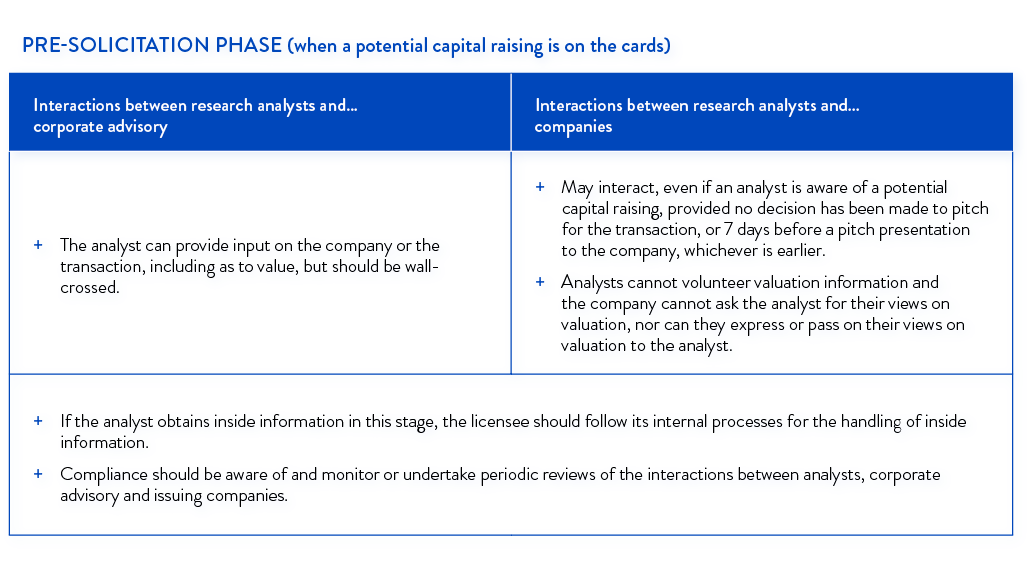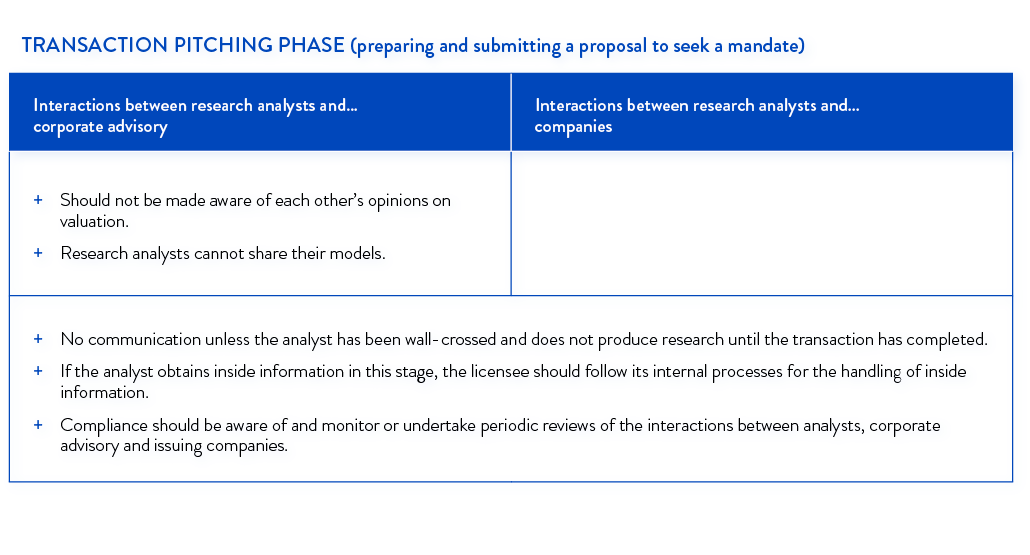ASIC has introduced its new regulatory guidance on analyst sell-side research, after an extensive review and industry consultation process.
In Regulatory Guide 264 Sell-side research (RG 264) ASIC has tempered some of the more worrisome proposals from its draft guidance, although the introduction of more oversight and involvement by compliance teams will still create a burden for smaller research providers, and the guidance regarding interactions between research analysts and others interested in capital raisings is very prescriptive.
Some key takeaways from RG 264 are discussed below:
- Investor Education Reports (IERs):
- Despite objections raised during the public consultation process, RG 264 prevents disclosure in IERs of any company or valuation information, estimate or plans that will not be disclosed in the prospectus. This requirement will be practically challenging, as an analyst will not be in a position to know what information will be included in the final prospectus at the time his or her IER is published (although ASIC requires that any briefing to an analyst be restricted to information that is generally available or reasonably expected to be included in the prospectus). This will also mean that other valuation methods commonly used by research analysts but not included in prospectuses, including forecast future cash flows for discounted cash flow analysis and comparative business metrics, will be prohibited from IERs under the new RG 264.
- Given the important role that IERs play in price discovery, ASIC will continue to allow valuations to be included in IERs, although ASIC has signalled that they will continue to monitor the issue and may revisit the inclusion of valuations in IERs at a later date. RG 264 permits valuation information, so long as it is expressed as an enterprise or total valuation for the company and accompanied by certain health warnings. ASIC’s new restrictions on interactions between analysts, corporate advisory teams and companies (detailed further below) are designed to minimise the risk that an analyst may be pressured into providing a favourable valuation.
- RG 264 prohibits disclosure of the draft IER to corporate advisory staff prior to publication, despite the benefit that communication between research analysts and corporate advisory can have during the review of a draft IER in identifying fundamental errors (whether in the IER or the prospectus itself). During the fact-checking stage prior to publication, the draft IER can only be provided to the issuing company and its legal advisers (with valuation information redacted), reducing the input of any non-legal advisers in the process.
- involvement by compliance: whilst the overall role of the compliance function has been reduced since the first draft of ASIC’s guidance, implementation of RG 264 will still require some additional investment in compliance personnel, as ASIC is clear that control frameworks are required in order to avoid relying on staff integrity alone. Compliance staff should undertake periodic monitoring to assess the effectiveness of the licensee’s inside information and conflict management policies, which could include attending meetings where both research analysts and corporate advisory staff are present, and reviewing communications between research and non-research staff (including emails, instant messaging, physical notes, audio recordings and real-time keyword hits). Once appointed, and the initial analyst briefing has taken place, compliance staff should act as a “go-between” in interactions between research and non-research staff, and between research analysts and the company.
- inside information: research providers will need to develop specific policies, procedures and training to ensure analysts appropriately identify and manage inside information, as the guidance encourages analysts to assume all unannounced information constitutes inside information. Although the assessment of what constitutes inside information is really one more appropriately made by issuers (and listed entities must also have processes in place for managing inside information), research providers will be required to ensure that their staff are trained to assess the nature of all information they receive, and manage it accordingly.
- appointment: companies will be required to appoint the lead managers before they can commence briefing their research analysts to avoid perceived independence issues arising for the analyst.
RG 264 provides detailed guidance for interactions between research analysts and companies (both listed and unlisted) at different stages throughout the capital raising life-cycle.



Finally, the new guidance contains some important positive departures from the draft guidance– here are our “Top 3”:
- Research analyst declaration: Following negative industry feedback, RG 264 reduces some of the potential liability on the analyst in their personal capacity. Analysts are still required to certify that they are not in receipt of, and their report does not contain, inside information, but the certification will no longer be required to be published in the report, but will be for internal purposes only, and will be given to the best of the research analyst’s knowledge.
- Replacement of IER: The new guidance allows for an IER to be amended if errors are identified or new information comes to light after the release of the IER which renders statements or information in it materially false, misleading or deceptive. The draft guidance did not permit any amendment, update or replacement of the IER once issued – only withdrawal of the report was permitted.
- Disclosure of interests: The draft guidance proposed that research reports include disclosure of the number of shares and options held by the research analyst and the 5 largest share and option holders at the licensee. Whilst ASIC no longer requires this disclosure, RG 264 does require that research reports include disclosure of any material interest the licensee and its employees have in financial products the subject of the research, including details of the licensee’s beneficial interests in securities.
Industry participants will have until 1 July 2018 to confirm their compliance practices to the new guidance.

Visit SmartCounsel
